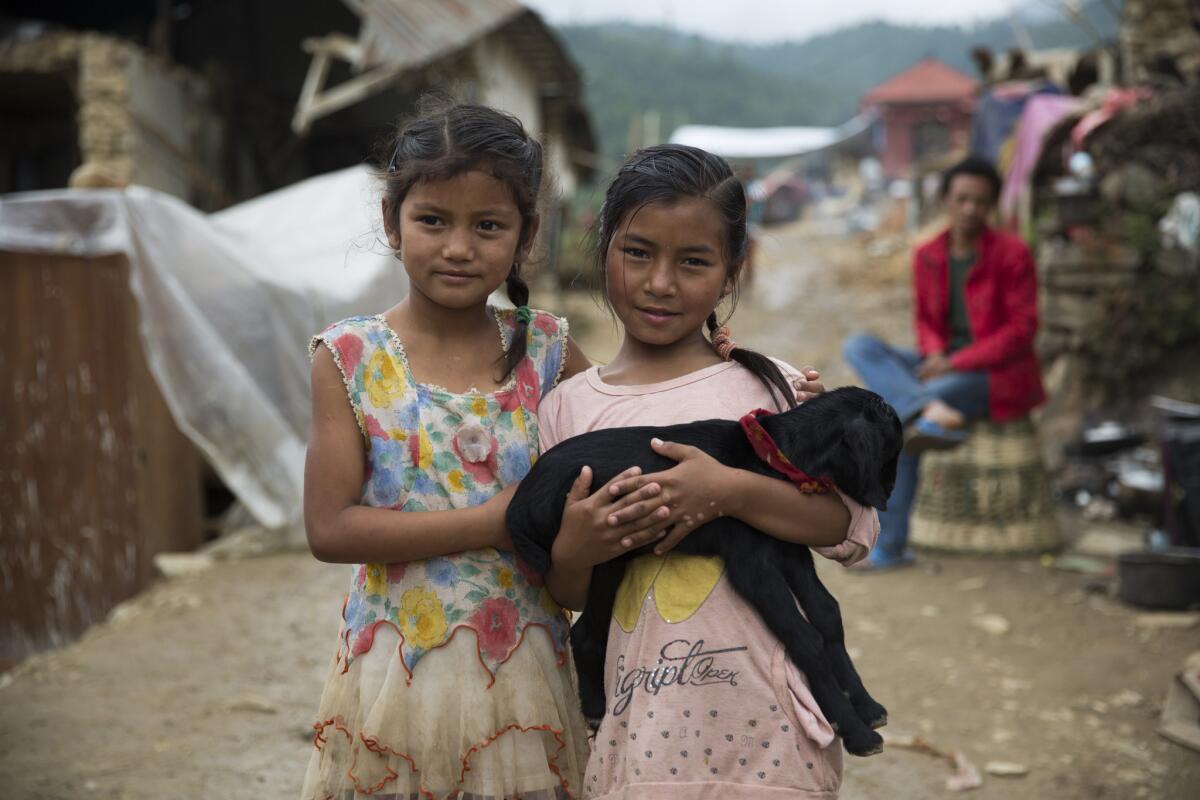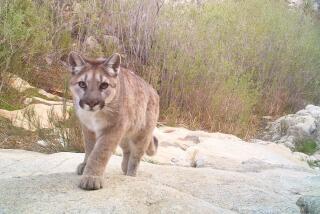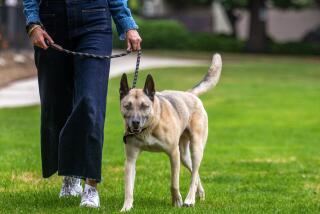Turning attention to Nepal’s four-legged (or feathered) quake victims

Two girls -- Dipika, left, and Susila -- hold a family goat in Pahade Thapa Gaon, an agricultural village outside Katmandu where the Humane Society International has deployed emergency animal welfare aid.
Three dogs with broken legs have been waiting days for surgery at the Vet For Your Pet clinic in this city just east of Katmandu. But with his family camped out in his ground-floor storefront and his support staff off tending to their households in the wake of last week’s massive earthquake, veterinarian Pranav Raj Joshi has had to hold off operating.
“I hope by Monday we can do the amputations,” Joshi said Saturday. “The fractures are too severe [to repair], but they’ll do fine on three legs once we can complete the surgery.”
In the first few days after Nepal’s April 25 quake, Joshi was occupied around the clock trying to help people in his immediate vicinity. He pulled bodies out of collapsed brick buildings and ferried corpses to the morgue in his jeep. “I was out of my head,” he recalled. “I didn’t know who I was helping; I just kept moving, moving, moving.”
But with the initial human-focused search, rescue and first aid efforts now moving past the emergency stage, Nepalese veterinarians such as Joshi -- along with domestic and international animal welfare organizations and pet and livestock owners -- are assessing the temblor’s effect on animals and trying to deal with myriad problems.
In any disaster, the death and injury of animals, and the loss of their owners or shelters, has emotional, financial and health consequences for both individuals and communities. In particular, there is concern that the carcasses of dead animals could spread disease.
Surendra Maharjan, 33, lost all his five of his cows when his neighbor’s building collapsed on his livestock shed in Shova Bhagawati. He used to make about $35 a day selling milk to nearby shops. “This was my only business, and selling milk is all that I know; I don’t know how I will raise my family with all my cattle gone,” he said.
In Paslang, a hilltop farming village 50 miles northwest of Katmandu where most homes were damaged or destroyed, residents said the quake killed two buffalo and a goat when the tin roofs of their sheds collapsed. Other cattle were hurt by falling debris.
“No veterinarians have come to treat the sick animals,” lamented Khil Bahadur Ranamagar, 28, who suffered a broken leg.
Farming families in Paslang rely on the animals as insurance during lean harvest years, and often sell their milk at market. Ranamagar said the toll could have been much worse but since the quake happened at midday, many animals were out in the fields.
Properly disposing of the carcasses of dead animals such as the cows crushed in Paslang is important for containing the spread of diseases including anthrax and plague. But it’s not just collapsed rural barns that contain such vectors.
In Bhaktapur, for instance, many families raised goats on the top floors of their now-ruined three- to five-story brick homes in the warrens of the old city. On the outskirts of town, a multistory poultry house with 9,000 birds was flattened by the quake. In the center of Katmandu, debris piles are full of pigeons that were perched in the eaves of old temples when the quake struck; the birds simply could not fly out fast enough.
With the government overwhelmed just trying to attend to human needs for food and shelter, animal specialists worry about a looming public health crisis.
“Carcass disposal has been a big dilemma,” said Manoj Gautam, president of the Animal Welfare Network of Nepal (AWNN) and executive director of the Jane Goodall Institute Nepal. “From an animal welfare point of view, we can’t prioritize carcass disposal, but it does have an impact on health so we are looking for ways to support local officials on this front.”
Many pets and livestock that did survive the earthquake have been rendered homeless. In some cases, their owners have died; in other cases, their now-homeless owners have been unable to take their animals with them to tent encampments or back to their relatives’ homes outside of Katmandu. In Bhakatpur, goats that were being raised for meat are now roaming the city’s ancient brick squares.
AWNN, an umbrella group, is now coordinating with outside organizations such as Humane Society International to bring in veterinarians and food supplies and procure necessary vaccines and medicines for sick and injured animals.
Adam Parascandola, director of animal protection and crisis response with Humane Society International, said that within Katmandu, the capital, the priority is pets that were left behind or that are with families who are having trouble keeping them.
“If people are homeless and can’t care for their animals, we need to help them with food, veterinary care and vaccinations,” he said. His group is trying to identify a facility to use as a temporary shelter. The aim is to care for pets for a few months and reunite as many as possible with their owners once their living situation stabilizes.
Outside of urban areas, Parascandola said, the priority is livestock. Contaminated water supplies and loss of barns, in addition to the stress of the disaster, can put cows, goats and other farm animals at risk for respiratory ailments, hoof disease and other problems.
Rahul Sehgal, Asia director for Humane Society International, said a typical Nepalese farmer would have two large animals, such as cows, and perhaps 10 small ones, such as goats.
“Normally, these animals would be out grazing,” he said, “but after the earthquake, with people dealing with many problems, a lot of these animals are being tethered. That leads to stress and also sanitation problems, and then there’s the issue of getting food to these animals.”
Parascandola said one of the big challenges in Nepal is the remoteness of many places. “You can spend a day getting to just three or four villages, and there are thousands of villages -- it’s not like other places where we’ve recently had earthquakes, like Haiti,” he said. “Even with the various groups here, it’s very difficult.”
Groups like AWNN and Humane Society International are mindful that some people may chafe at the idea of helping animals while people still need assistance.
“While humans are suffering so much, some people may think it’s inappropriate to talk about animals,” acknowledged Gautam, who himself lost a niece in the earthquake. “So we are trying to get aid supplies for humans and take those in parallel, so that people don’t get angry.”
Sehgal agreed. “We don’t want to be in a situation where we arrive somewhere trying to help animals and there’s a human dying,” he said. “Every team that goes out to help animals will also help humans.”
In the initial days of the disaster response, there has been some tension over priorities and tactics between local veterinarians such as Joshi and international animal welfare groups that have parachuted into the country.
Joshi, for instance, has been irked by the foreigners’ lack of capacity to help with carcass disposal, and their suggestion that rescued dogs could be flown out to adoptive homes as far away as the United States.
“Shipping one dog to the U.S. costs $1,000,” he said. “You can build a house for a Nepalese for that much money.”
But Julie Hoag, an American veterinarian who has been practicing in Nepal for several years, is encouraging the locals and foreigners to find common ground and a way forward together. “The needs are too great not to,” she said.
Staff writer Shashank Bengali in Paslang and special correspondent Bhrikuti Rai in Katmandu contributed to this report.
Follow @JulieMakLAT on Twitter
More to Read
Start your day right
Sign up for Essential California for news, features and recommendations from the L.A. Times and beyond in your inbox six days a week.
You may occasionally receive promotional content from the Los Angeles Times.







